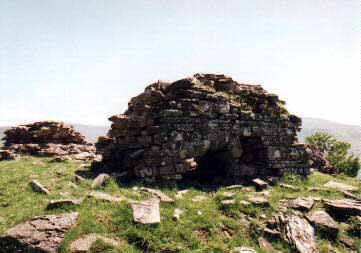- Aberllynfi Castle
- and the
- Clifford War of 1233
A good detailed description of Aberllynfi castle (SO.171380) has been published by the late Richard Kay in the Woolhope Club, Herefordshire Archaeological News 61, 26-7. Below are some extracts from my researches which have turned up a few references to this site during the war of 1233. These suggest both the family that built the castle and something of the condition of the Herefordshire border during the early thirteenth century.
At the end of July 1233, a revolt appears to have broken out amongst the Herefordshire Marchers, led primarily by Walter Clifford of Clifford (1190-1263) and at the instance of Earl Richard Marshall of Pembroke. Walter's nephew, Roger Clifford, was later to be one of the initial leaders of the barons' revolt of 1263. On 31 July 1233 King Henry III ordered Sheriff William Fitz Warin of Herefordshire, to arrest any armed bands and appeared himself at Hereford on 19 August. Henry moved rapidly, capturing from the Cliffords in rapid succession the castles of Clifford, Aberllynfi, Hay on Wye, Glasbury and Bronllys, probably by 23 August 1233 when it was noted that Walter Clifford's lands were in the king's hands. On 29 August the household knight, Baldwin Gisnes, was ordered to relinquish the custody of Glasbury (Glasbiry) castle to William Fitz Warin. Baldwin was similarly ordered to relinquish Bronllys (Brenles) on 1 September and possibly the other Clifford castles which he is soon found holding. On the same day the king ordered the constable of Hay to hand over to one Inges the Crossbowman (balistario) the land of Aberllynfi (Abberlewin) that had belonged to Hugh Kinnersley, a knight of Walter Clifford.
During the August war the strength of the king had proved too much for Walter Clifford. Henry III, however, had failed to overawe the Earl Marshall and the Bassets, although the warring parties had come to a compromise truce on 7 September 1233 at Usk. Consequently Walter Clifford, on 17 September, made his peace with the crown at Shrewsbury, after having failed to secure the support of his father-in-law, Prince Llywelyn ab Iorwerth. However, Walter's return to the king's peace did not regain him and his followers their castles back until the Welsh emergency was over next year. In the meantime the experienced soldier Henry Turbeville had been appointed to guard the castles of Usk, Clifford, Aberllynfi, Hay on Wye and Corfham for the king, and it was in this office that he was mandated by the king to go to the relief of Pipton (Periton) castle on 23 September 1233. Pipton castle been entrusted to William Gamage (the dispossessed lord of Boughrood) and it was now being besieged by the irrepressible Roger Boghan (c.1228-c.1248), grandson of Prince Einion Clud of Elfael (killed 1177) and one of the several native claimants to the lordship of the Welsh in the cantref of Elfael. Unfortunately we know nothing of the outcome of the siege or the fate of Pipton castle. However Roger's son Rhys, after many tribulations, was still holding the lordships of Boughrood and Trewern as late as 1279, when he was forced to relinquish them to Henry Pembridge and his wife, the Gamage heiress. In the meantime Henry Turbeville obviously lost control of Aberllynfi castle. On 25 September the king wrote to Henry complaining that although he had passed the castle over to Inges the Crossbowman it had subsequently been seized by its old lord, Hugh Kinnersley, by violence and that Hugh had subsequently fortified the fortress with a garrison against the king. Turbeville was therefore ordered to retake the castle either subduing those within it or taking them unharmed into custody. Regardless of the outcome of his assault he was to turn all the chattels of Aberllynfi manor over to Inges. Hugh Kinnersley obviously survived Henry Turbeville’s assault for on 20 May 1234 he was fined 20 marks to be re-admitted to the king’s peace. With this order the brief history of Aberllynfi castle apparently comes to an end.
The story of the Kinnersleys does not end here though. Richard Kinnersley was lord of Melinog in Brycheiniog from at least 1208, while Hugh Kinnersley was his younger brother and successor. His first recorded act was help found Craswall priory around 1220. He also witnessed many charters for the Cliffords and Tregoz as a lord in both Herefordshire and Shropshire. He was also lord of Kinnersley in Herefordshire under the Mortimers of Wigmore. Hugh’s bravado in 1233 certainly brought him royal recognition and from 1234 onwards he was often found undertaking military missions for King Henry III. By 1250 he had risen to be sheriff of Herefordshire, though he was forced to quit his post through illness.
The above narrative raises some interesting points for castle studies in the Wye valley. The first is the sheer number of operational castles in such a confined area at this time. The Wye, like the Rhine, must have been a river literally studded with castles and fortified places. It also shows that what now look like insignificant eleventh and twelfth century sites were in the thirteenth century still capable of serious defence, ie. Aberllynfi and Pipton. It is an interesting thought to ponder on how many of those barely recorded sieges of the Middle Ages ended with the collapse of the garrison's morale, and how many by force majeur? Having recently visited Restormel castle in Cornwall, it is easy to draw a comparison with this castle that never saw siege and the comparatively insignificant Aberllynfi which did. The shell keep at Restormel is still almost intact, but the entire bailey, which was known to be of stone and contained many stone buildings, is now virtually impossible to trace. How many of our other great castles have been similarly degraded?
